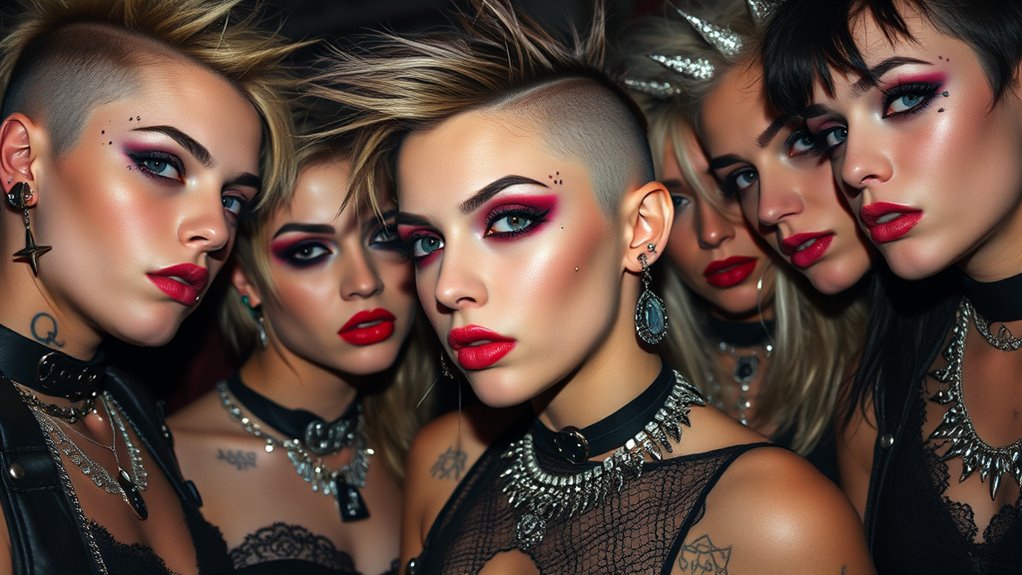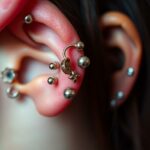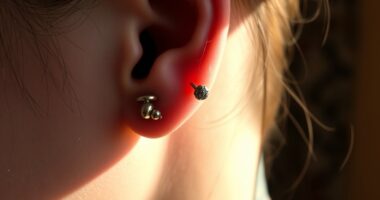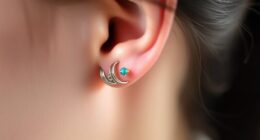Piercings in subcultures like punk and goth act as bold symbols of identity, rebellion, and belonging. They help you express your values and connect with like-minded groups through styles and placements that carry deeper meanings beyond aesthetics. Punk piercings often challenge norms with facial jewelry, while goth piercings evoke mystery with dark-toned jewelry. Exploring these styles reveals how piercings shape personal and cultural stories—discover more ways these symbols reflect your unique style.
Key Takeaways
- Piercings serve as symbols of identity, rebellion, and cultural belonging within subcultures like punk and goth.
- In punk culture, facial piercings express nonconformity and resistance to mainstream norms.
- Goth piercings often feature dark jewelry and facial modifications, emphasizing individuality and gothic aesthetics.
- Piercings act as visual language, signaling group allegiance and personal values across various subcultures.
- Beyond fashion, piercings are tools for self-expression, body art, and redefining beauty standards within diverse communities.

Piercings have long served as powerful symbols of identity and belonging within various subcultures. They often carry deeper meanings beyond just aesthetics, acting as expressions of personal values, rebellion, or cultural connections. Within these groups, piercings are more than adornments—they’re statements that communicate who you are and what you stand for. This idea ties closely to tattoo symbolism, where each design carries specific meanings, but piercings also become part of a visual language that defines a subculture’s identity. For many, piercing choices are deliberate fashion statements that challenge mainstream norms and showcase allegiance to a particular community. Whether it’s a simple nose ring, a set of ear piercings, or more daring facial modifications, each piece becomes a marker of belonging and individuality. Additionally, the placement and type of piercings can reflect specific cultural or ideological values, making them a meaningful form of body modification. In punk culture, piercings are almost synonymous with rebellion and nonconformity. You might choose multiple facial piercings, like studs or rings along the eyebrows, lips, or septum, to express your defiance against societal standards. These adornments often complement other punk fashion statements—leather jackets, band tees, and ripped jeans—creating a cohesive look that screams individuality. The act of piercing itself becomes a statement of resilience, a way to show that you’re unafraid to challenge conventional beauty norms. Punk piercings aren’t just about aesthetics; they symbolize a rejection of mainstream values, making your body a canvas for activism and self-expression. In goth circles, piercings tend to take on a darker, more mysterious tone. You might opt for black or dark-colored jewelry, with piercings placed to evoke a sense of elegance or mystique. Facial piercings such as septums or eyebrow rings are common, often paired with dramatic makeup and dark fashion statements. These choices aren’t random—they reflect a fascination with the gothic aesthetic, which emphasizes individuality, introspection, and often, a fascination with the macabre. Your piercings become part of your overall look, echoing the gothic ethos through tattoo symbolism and jewelry that creates a sense of otherworldliness and personal depth. Beyond punk and goth, other subcultures also incorporate piercings as crucial symbols of identity. Body modification communities, for example, see piercings as a form of art and self-discovery. For some, these modifications are a way to push boundaries and redefine beauty standards. In all these contexts, piercings serve as powerful tools for crafting a visual identity that aligns with your values and group affiliation. They’re not just fashion statements—they’re a form of language, a way to tell your story and connect with others who share your worldview.
Frequently Asked Questions
How Do Subcultures Influence Piercing Styles Over Time?
Subcultures influence piercing styles over time by shaping fashion trends and encouraging artistic expressions. As you embrace a subculture, you’re likely to adopt specific piercing styles that reflect its identity, pushing boundaries and inspiring others. These evolving trends often blend traditional and innovative designs, creating a dynamic landscape of self-expression. You become part of a movement that continuously redefines beauty standards, making your piercings a powerful statement of your cultural affiliation and personal identity.
Are There Specific Piercings Associated With Each Subculture?
You might think specific piercings scream “this is my subculture,” but honestly, it’s more about the style and meaning behind them. Goths favor dark, ornate jewelry, while punks often sport safety pins or facial piercings—proof that alternative jewelry is a rebellious statement. Each piercing carries cultural symbolism, subtly signaling your allegiance or aesthetic, making them more than just adornments—they’re badges of identity in a world obsessed with labels.
What Are the Cultural Origins of Piercings in Punk and Goth Communities?
You should know that the cultural origins of piercings in punk and goth communities stem from their desire for rebellion and identity. In punk culture, piercings symbolize defiance and historical symbolism linked to anti-establishment sentiments. Goth communities adopt piercings to express individualism and darker aesthetic themes, reinforcing their cultural identity. These modifications serve as powerful symbols of personal and collective history, shaping their unique subcultural expressions.
How Do Piercings Impact Social Acceptance Within Subcultures?
Piercings markedly influence your peer acceptance within subcultures by serving as bold expressions of identity. When you choose piercings aligned with punk or goth styles, you signal your belonging and commitment to the community. These body modifications can boost your confidence and help you connect with like-minded individuals, reinforcing your sense of identity expression. Ultimately, piercings become a visual badge that fosters acceptance and shared values within the subculture.
What Are the Health Risks Specific to Subculture-Inspired Piercings?
Think of your piercing as a delicate garden that needs careful tending. Subculture-inspired piercings carry infection risks and allergic reactions if not properly cared for. For example, using cheap jewelry can trigger allergies, and poor hygiene can lead to infections. You might love expressing yourself, but neglecting these risks can turn your body into a battleground. Always choose quality jewelry and follow aftercare instructions to keep your body healthy.
Conclusion
Piercings in subcultures aren’t just accessories—they’re powerful symbols of identity and rebellion. Whether you’re punk, goth, or beyond, your piercings tell a story that’s louder than words. They connect you to a community that’s as fierce as a wildfire and as vibrant as a rainbow. So, if you’re thinking about expressing yourself, remember: your piercings might just turn the world into your personal canvas, shaping your identity in ways you never imagined.
















